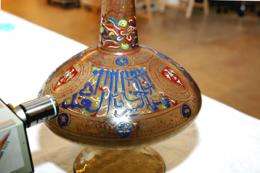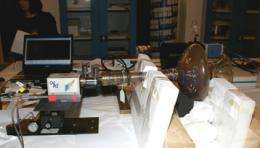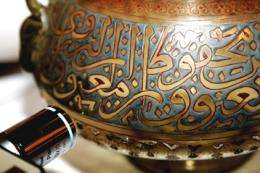Chemistry sheds light on Mamluk lamps

The Department of Islamic Art, Musée du Louvre, will re-open to the public on September 22, 2012. Among the items to be exhibited are four large lamps and a long-necked enameled glass bottle dating from the Mamluk period (1250-1517), which have recently been analyzed on site for the first time. This analysis was made possible by the use of a non-invasive, mobile technique: Raman spectroscopy. Conducted by a team of physical chemists from the Laboratoire de dynamique, interactions et réactivité (CNRS/UPMC) in collaboration with the Department of Islamic Art, Musée du Louvre, this study uncovers the palette of pigments used during the period to achieve the objects' vibrantly colorful decoration. Blue, for example, was obtained using either lapis lazuli or cobalt. The results of this research have been published in The Journal of Raman Spectroscopy, shedding new light on the manufacture of Mamluk enameled glass and providing hitherto unknown information on these rare, fragile, and valuable artifacts.
The Department of Islamic Art, Musée du Louvre, is home to an exceptional collection of enameled glassware from the Mamluk period. Due to their fragility and value, these objects cannot be moved for analysis. Consequently, they have been the subject of very few comprehensive studies. Closure of the Department of Islamic Art for renovation provided an unprecedented opportunity for the detailed, exhaustive analysis of some of this glassware. In 2010 and 2011, four Mamluk mosque lamps and a long-necked bottle exceeding 30cm in height, all dating from the 14th century, were measured using Raman spectroscopy, a non-destructive, portable technique that avoids contact with the objects. The principle is simple: the sample is illuminated by a monochromatic, coherent laser beam. A very small amount of this light is scattered with a shift in exit energy: it contains information on the composition and organization of matter, its production method, and state of conservation. The effectiveness of the technique had already been demonstrated, notably by the on-site analysis of the stained glass windows in Paris's Sainte-Chapelle in 2005.

The range of methods used in the manufacture of Mamluk enameled objects remained elusive until the team from the Laboratoire de dynamique, interactions et réactivité (CNRS/UPMC) resolved to uncover the mystery. These scientists have now shown that to obtain blue, enamellers of the period sometimes used lapis lazuli. Certain sites in the structure of this rare mineral contain polysulfide ions, which are responsible for its ultramarine color. Though found in paintings and sometimes in frescos, lapis lazuli was not considered sufficiently stable chemically to have served as a pigment in ceramics and glass. Recent examples of the use of this pigment in 13th and 14th century ceramics have however come to light, occasionally combined with cobalt blue.
Surprisingly, in the green enamels, only one piece gave a signal specific to lapis lazuli, combined here with Naples yellow4. In the other four objects, green was obtained by mixing Naples yellow and cobalt blue. As the intensity of the two blue pigments is very similar, the reasons for the master glassmakers' choice of one or the other, or both, remain obscure. Finally, like cobalt blue, lapis lazuli has proven to be thermally stable, which confirms that it is compatible with the conditions required for enameling (heating to 600-900°C). White meanwhile was obtained with tin oxide precipitates – the Islamic potters' traditional solution – or in some objects, calcium phosphate.

The different methods of obtaining green and white are used for categorizing Mamluk enameled glassware into three groups, which corresponds fairly closely to the classification established by curators based on visual criteria (decoration, brightness of the enamel, inscriptions, dating, etc.). A comparison between Mamluk pieces from the Louvre and replicas by 19th century master glassmakers unambiguously shows that very different pigments (arsenate white, cobalt blue, and lead chromate yellow) were used in that later period.
This study therefore helps distinguish recently restored sections or copies. Identification of manufacturing processes typical of the Mamluk period and use of portable characterization instruments have made it possible to authenticate Mamluk artifacts. It remains to be determined whether the Mamluk pieces from other museums fit this classification.
More information: Pigments and enamelling/gilding technology of Mamluk mosque lamps and bottle. Philippe Colomban, Aurélie Tournié, Maria Cristina Caggiani and Céline Paris. The Journal of Raman spectroscopy. Online since July 17, 2012.
Journal information: Journal of Raman Spectroscopy
Provided by CNRS



















